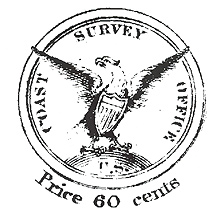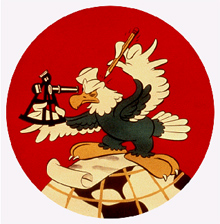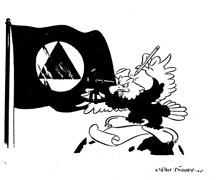The Coast and Geodetic Survey Disney Eagle
Since the Civil War, NOAA and its predecessor agencies have played a crucial role in providing information, such as nautical charts, in defense of our homeland. Symbols of these times, such as the Disney Eagle created for the Coast and Geodetic Survey during World War II, still remain, adding some humor and nostalgia to the rich history and contributions of the agency.

The eagle design created by Disney was most likely based on this old Coast Survey crest of an eagle sitting on a globe. Click image for larger view.
During World War II (WWII), several design studios created shoulder patch designs for U.S. military units from all branches of the service. Amongst these studios were the Walt Disney Studio, Warner Brothers Studio, RKO Pictures, and Metro-Goldwyn-Mayer (MGM). Many of the designs were humorous and intended to boost morale and instill pride in military units. By the end of the War, the Disney Studio alone had created over 1,200 designs for U.S. uniformed services.
The C&GS Disney Eagle
Not to be outdone by other branches of service, the U.S. Coast and Geodetic Survey (C&GS) applied to Disney for the development of an insignia. As a result, a wonderful design was created.

The inspired designs created by Disney, such as the eagle created for C&GS, raised the spirit of troops. By the end of World War II, Disney's five-man staff assigned to insignia completed over 1,200 unit insignias, never charging a fee to the military.
In the Disney design, the Eagle is atop a globe, busy carrying out the work of the Survey – making nautical charts.
The Eagle is wearing a sailor’s hat, signifying the maritime nature of charting work and uniforms worn by ship officers and crew. The Eagle holds a pencil with one wing for entering information onto the chart at his feet. With the other wing, he holds a sextant, used for measuring angles between objects on shore with known positions. Such measurements were done to determine the position of the survey vessel at the same time that a water depth measurement was being taken.
C&GS in World War II
Throughout WWII, C&GS officers and civilians served in North Africa, Europe, and throughout the Pacific. These individuals served as artillery surveyors, hydrographers, amphibious engineers, beach masters, reconnaissance surveyors for the worldwide aeronautical charting effort, instructors at service schools, and in a plethora of other technical positions.

The C&GS Eagle made appearances throughout the war. Here, the C&GS flag is the back-drop for the Eagle. Click image to view slide show with larger images.
In Europe, the work of C&GS artillery surveyors assured the success of the devastating tactic of "time-on-target," a method of coordinating different artillery batteries to concentrate their fire on a single point. In the Pacific, C&GS ships often operated in advance of fleet units. Of the USS Pathfinder, a C&GS ship taken over by the Navy for the duration of the war, it was said that, “the road to Tokyo was paved with Pathfinder charts.”
C&GS amphibious engineers were regimental navigators for Army engineer shore and boat regiments moving men and supplies during General MacArthur's “leap-frog” war up New Guinea and into the Philippines. In the worldwide aeronautical charting effort of WWII, C&GS officers were reconnaissance surveyors with the Army Air Forces, traveling throughout the world pioneering many of today's civil air routes.
On the home front, C&GS chart makers provided close to 100 million charts and maps to the Allied forces. These efforts included press runs of over 1,800 target charts of such areas as Ploesti and Hiroshima. Adding to the total contribution of the C&GS to the war charting efforts was the assignment of a C&GS officer as the first commanding officer of the Army Air Forces Aeronautical Chart Plant at St. Louis, Missouri.
The Disney Eagle design, which accompanied these brave men and women on their exploits, appeared in numerous places. It has been painted on the smoke stack of a Survey ship; the nose of a Survey aircraft; made into patches; carved on the front door of a house; used on T-shirts, caps, postal first-day-covers, newsletters; and appeared in other similar places.
Contributed by Commander George E. Leigh, NOAA Corps (Ret'd.)
